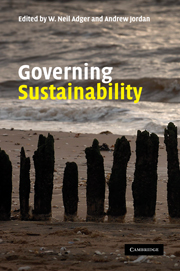Book contents
- Frontmatter
- Contents
- List of figures
- List of tables
- List of contributors
- List of abbreviations
- Foreword by Jonathon Porritt CBE
- Preface
- Part I Overview and Context
- Part II Governance and Government
- 3 Governance, government and the pursuit of sustainability
- 4 How do environmental actors make governance systems more sustainable? The role of politics and ideas in policy change
- 5 Global governance for sustainable capitalism? The political economy of global environmental governance
- Part III Governance and Civil Society
- Part IV Governance and Decision Making
- Part V Conclusions
- Index
- References
3 - Governance, government and the pursuit of sustainability
Published online by Cambridge University Press: 05 June 2012
- Frontmatter
- Contents
- List of figures
- List of tables
- List of contributors
- List of abbreviations
- Foreword by Jonathon Porritt CBE
- Preface
- Part I Overview and Context
- Part II Governance and Government
- 3 Governance, government and the pursuit of sustainability
- 4 How do environmental actors make governance systems more sustainable? The role of politics and ideas in policy change
- 5 Global governance for sustainable capitalism? The political economy of global environmental governance
- Part III Governance and Civil Society
- Part IV Governance and Decision Making
- Part V Conclusions
- Index
- References
Summary
Introduction
The sustainability agenda is large and radical. It covers inter-generational justice, resource use, pollution, urban and rural planning, participation, poverty and social inclusion. Faced with such a broad agenda, the political scientist is likely to despair and say that there have to be some boundaries around the concept, otherwise it becomes unworkable. This is too hasty a reaction. Sustainable development is open-textured as a concept but, in some contexts, this is an advantage rather than a handicap. It reminds us that there may be structural flaws of social and political organisation that need to be remedied rather than treating problems as anomalies to be rectified or discrete issues to be addressed. On the other hand, we cannot say something about everything at once. So I shall take the privilege of focusing on one component of sustainable development, namely that concerned with environmental protection, and in particular on the problems of institutional design in environmental governance. Although environmental protection is a necessary, and not a sufficient, condition of moving towards sustainability, we learn something by focusing upon a central case.
How might lessons from political science relate to the theme of sustainability? If any message comes out of the ethics of sustainability, it is that human beings live well when they learn to live within limits. Indeed, it is an error to think that scarcity and limits, in and of themselves, are a form of evil or misfortune.
- Type
- Chapter
- Information
- Governing Sustainability , pp. 55 - 75Publisher: Cambridge University PressPrint publication year: 2009
References
- 10
- Cited by

